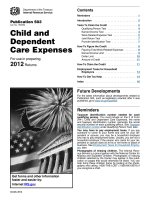Anesthesia and perioperative care for aortic surgery
Bạn đang xem bản rút gọn của tài liệu. Xem và tải ngay bản đầy đủ của tài liệu tại đây (22.11 MB, 464 trang )
Anesthesia and Perioperative
Care for Aortic Surgery
Kathirvel Subramaniam
Kyung W. Park
Balachundhar Subramaniam
Editors
Anesthesia and
Perioperative Care
for Aortic Surgery
Editors
Kathirvel Subramaniam, MD
Clinical Assistant Professor
University of Pittsburgh Medical
Center - Presbyterian Hospital
Department of Anesthesiology
Pittsburgh, PA
USA
Kyung W. Park, MD, MBA
Departments of Anesthesia and
of Surgery
The Ohio State University Medical Center
Doan Hall 168, 450 W. 10th Avenue
Columbus, OH
USA
Balachundhar Subramaniam, MBBS, MD
Assistant Professor in Anesthesia
Harvard Medical School
Director
Division of Cardiovascular
Anesthesiology Research
Beth Israel Deaconess Medical Center
Boston, MA
USA
ISBN 978-0-387-85921-7 e-ISBN 978-0-387-85922-4
DOI 10.1007/978-0-387-85922-4
Springer New York Dordrecht Heidelberg London
© Springer Science+Business Media, LLC 2011
All rights reserved. This work may not be translated or copied in whole or in part without the
written permission of the publisher (Springer Science+Business Media, LLC, 233 Spring
Street, New York, NY 10013, USA), except for brief excerpts in connection with reviews or
scholarly analysis. Use in connection with any form of information storage and retrieval,
electronic adaptation, computer software, or by similar or dissimilar methodology now known
or hereafter developed is forbidden.
The use in this publication of trade names, trademarks, service marks, and similar terms, even if
they are not identified as such, is not to be taken as an expression of opinion as to whether or not
they are subject to proprietary rights.
While the advice and information in this book are believed to be true and accurate at the date
of going to press, neither the authors nor the editors nor the publisher can accept any legal
responsibility for any errors or omissions that may be made. The publisher makes no warranty,
express or implied, with respect to the material contained herein.
Printed on acid-free paper
Humana Press is part of Springer Science+Business Media (www.springer.com)
I dedicate this textbook to my parents (Palaniammal
& Subramaniam), my wife (Dalia), my children
(Manav & Manas) and my teachers.
Kathirvel Subramaniam
This book would not have been posible without the support
and patience of my family, for which I am most grateful
Kyung W. Park
I would like to dedicate this work to my wife (Kalpana), kids
(Nirmal, Pavi and Amal) and my parents (Parimala and
Subramaniam)
Balachundhar Subramaniam
Preface
Some 15 years ago, as the authors were all working at a high-volume vascular
surgical center of the Beth Israel Deaconess Medical Center in Boston, there
was a realization that patients undergoing vascular surgery present the anesthesiologist with a unique set of challenges. These patients are usually elderly
with a host of cardiac, cerebrovascular, renal, and metabolic comorbidities,
which are usually expected to get worse either transiently or permanently
with the insult of the major vascular surgery. Meeting the challenges is not
only a lofty goal for the anesthesiologists involved, but also is a requirement
predicated on the covenant relationship that the anesthesiologists have with
the patients. And doing so requires comprehensive understanding of the
pathophysiology and anatomy of the disease processes, the surgical techniques used to address the ailments, and the spectrum of anesthetic medications and monitoring modalities.
This book represents our best attempt to bring together these components
that need to be understood in order to properly meet the challenges of caring
for a complex vascular patient with a disease of the aorta and its major
branches. We have brought together the expertise and experience of some of
the best surgical, medical, and anesthetic minds on the subject. This book is
intended for cardiac anesthesiologists, cardiovascular surgeons, intensivists,
nurse anesthetists, residents, and fellows of these respective specialties who
are involved in the care of aortic surgical patients. Recent developments in
aortic surgery such as endovascular surgery make the older textbooks on this
subject obsolete.
Chapters include anatomical description of aorta, pathogenesis of acute
aortic syndrome, preoperative evaluation, detailed description of aortic surgery and anesthesia for specific aortic procedures (ascending aorta, arch,
descending aorta, endovascular surgery, trauma, and surgery for congenital
aortic pathologies). Intraoperative echocardiography and cerebral monitoring
have gained importance in cardiac surgery in recent years and separate chapters describe these monitoring techniques. Two chapters are devoted to specific organ protection (spinal cord and renal protection) since organ
dysfunction is a major cause of mortality and morbidity after aortic surgery.
The book ends with a concise description of postoperative care. Overall, this
is a complete textbook on aortic anesthesia, which will serve as a reference
for those involved in the care of aortic surgical patients.
vii
viii
viii
Preface
This book would not have been possible without the support of the editors
of Springer publishers, Brian Belval, Shelley Reinhardt, and Catherine
Paduani, for which we are most grateful. We are also indebted to Joanna
Perey, editorial assistant, and to Rebecca McArdle, our coach and development editor at Springer, for their undying support. We are thankful to all the
authors for their significant contributions. We are thankful to Christopher
Edwards and Shaw Kristin for their help with the artwork.
We hope that this book will help you to offer better care for aortic surgical
patients.
Kathirvel Subramaniam
Kyung W. Park
Balachundhar Subramaniam
Contents
1 Applied Anatomy of the Aorta
Jagan Devarajan and Balachundhar Subramaniam......................... 1
2 Acute Aortic Syndrome
Cynthia M. Wells and Kathirvel Subramaniam.............................. 17
3 Preoperative Cardiac Evaluation Before Aortic Surgery
Kyung W. Park................................................................................ 37
4 Role of Echocardiography in Aortic Surgery
Kathirvel Subramaniam and Balachundhar Subramaniam............. 47
5 Operative Techniques in Surgery of the Proximal
Thoracic Aorta and Aortic Arch
Enrique Gongora and Thomas G. Gleason..................................... 99
6 Anesthesia for Surgery of the Ascending Aorta
and Aortic Arch
Andrew W. Murray and Kathirvel Subramaniam........................... 123
7 Deep Hypothermic Circulatory Arrest
Tomas Drabek and Joseph J. Quinlan............................................. 145
8 Cerebral Monitoring During Aortic Surgery
Parthasarathy D. Thirumala, John M. Murkin,
Donald J. Crammond, Miguel Habeych, Jeffery Balzer,
and Kathirvel Subramaniam........................................................... 171
9 Understanding Open Repair of the Descending Thoracic
and Thoracoabdominal Aorta
Jay K. Bhama, Scott A. LeMaire, John R. Cooper,
and Joseph S. Coselli...................................................................... 195
10 Anesthesia for Descending Aortic Surgery
Kathirvel Subramaniam and John C. Caldwell............................... 211
ix
xx
11 Spinal Cord Protection Strategies
John G.T. Augoustides.................................................................... 239
12 Understanding Endovascular Aortic Surgery:
Endovascular Repair of Aortic Aneurysmal Disease
Richard C. Hsu and Marc Schermerhorn........................................ 257
13 Anesthesia for Endovascular Aortic Surgery
Adam B. Lerner.............................................................................. 281
14 Anesthesia for Open Abdominal Aortic Aneurysm Repair
Theresa A. Gelzinis and Kathirvel Subramaniam........................... 301
15 Renal Protection Strategies
Mark Stafford-Smith, Chad Hughes,
Andrew D. Shaw, and Madhav Swaminathan................................. 329
16 Comprehensive Management of Patients
with Traumatic Aortic Injury
Charles E. Smith and Donn Marciniak........................................... 349
17 Anesthesia for Adult Congenital Aortic Surgery
Barry D. Kussman and James A. DiNardo..................................... 379
18 Atherosclerosis of the Aorta and Prevention
of Neurological Dysfunction After Cardiac Surgery
Fellery de Lange, G. Burkhard Mackensen,
and Madhav Swaminathan.............................................................. 395
19 Postoperative Care After Aortic Surgery
Elnazeer O. Ahmed and Davy C. Cheng........................................ 417
Index....................................................................................................... 427
Contents
Contributors
Elnazeer O. Ahmed, MBBS, MD, FRCSI
Department of Cardiac Surgery, London Health Sciences Centre,
London, ON, Canada
John G.T. Augoustides, MD, FASE, FAHA
Department of Anesthesiology and Critical Care, University of
Pennsylvania Medical Center, Philadelphia, PA, USA
Jeffrey Balzer, PhD
Neurological Surgery, University of Pittsburgh Medical Center,
Pittsburgh PA, USA
Jay K. Bhama, MD
Division of Cardiac Surgery, Department of Cardiothoracic Surgery,
University of Pittsburgh Medical Center, Pittsburgh, PA, USA
John C. Caldwell, MD
Division of Cardiovascular Anesthesia, University of Pittsburgh Medical
Center – Presbyterian University Hospital, Pittsburgh, PA, USA
Davy C. Cheng, MD
Department of Anesthesia & Perioperative Medicine, London, ON, Canada
John R. Cooper, Jr, MD
Division of Cardiovascular Anesthesiology, Department of Surgery,
Baylor College of Medicine, and The Texas Heart Institute at St. Luke’s
Episcopal Hospital, Houston, TX, USA
Joseph S. Coselli, MD
Division of Cardiothoracic Surgery, Michael E. DeBakey
Department of Surgery, Baylor College of Medicine,
and The Texas Heart Institute at St. Luke’s Episcopal Hospital,
Houston, TX, USA
Donald J. Crammond, PhD
Department of Neurological Surgery,
University of Pittsburgh Medical Center, Pittsburgh, PA, USA
xi
xii
xii
Jagan Devarajan, MD, FRCA
Clinical fellow in Anesthesiology, Department of Anesthesiology,
Cleveland Clinic, Cleveland, OH, USA
Fellery de Lange, MD, PhD
Department of Anesthesiology, Division of Cardiothoracic
Anesthesiology and Critical Care Medicine,
Duke University Medical Center, Durham, NC, USA
James A. DiNardo, MD
Department of Cardiac Anesthesia, Harvard Medical School,
Children’s Hospital Boston, Boston, MA, USA
Tomas Drabek, MD
Department of Anesthesiology, University of Pittsburgh Medical Center,
Presbyterian Hospital, Pittsburgh, PA, USA
Theresa A. Gelzinis, MD
Department of Anesthesiology, University of Pittsburgh,
1 200 Lothrop Street, 15213, Pittsburgh, PA, USA
Thomas G. Gleason, M.D.
Department of Cardiothoracic Surgery,
Center for Thoracic Aortic Disease, University of Pittsburgh
Medical Center, Pittsburgh, PA, USA
Enrique Gongora, MD
Division of Cardiac Surgery, Department of Surgery,
Thoracic Transplantation and Mechanical Circulatory Support,
Heart Transplantation Program, Texas A&M Helath Science
Center College of Medicine, Scott & White Hospital and Clinics,
Temple, TX, USA
Miguel Habeych, MD, MPH
Department of Neurosurgical Surgery, University of Pittsburgh
Medical Center – Presbyterian University Hospital,
Pittsburgh, PA, USA
Richard C. Hsu, MD, PhD
Department of Vascular Surgery, Beth Israel Deaconess Medical Center,
110 Francis St Suite 5B, Boston 02215, MA, USA
Chad Hughes, MD
Division of Thoracic and Cardiovascular Surgery, Department of Surgery,
Aortic Surgery Program, Duke Heart Center, Duke University Medical
Center, Durham, NC, USA
Barry D. Kussman, MBBCh
Department of Anesthesiology, Perioperative and Pain Medicine,
Children’s Hospital Boston and Harvard Medical School,
300 Longwood Avenue, Boston, MA, USA
Contributors
Contributors
xiii
Scott A. LeMaire, MD
Division of Cardiothoracic Surgery, Michael E. DeBakey
Department of Surgery, Baylor College of Medicine, and The Texas Heart
Institute at St. Luke’s Episcopal Hospital, Houston, TX, USA
Adam B. Lerner, MD
Department of Anesthesia, Critical Care, and Pain Medicine,
Beth Israel Deaconess Medical Center, 330 Brookline Avenue,
Boston, MA 02215, USA; Department of Anesthesia, Harvard Medical
School, Boston, MA, USA
Donn Marciniak, MD
Department of Cardiothoracic Anesthesia, Cleveland Clinic Foundation,
Cleveland, OH, USA
G. Burkhard Mackensen, MD, PhD
Department of Anesthesiology, Duke University Medical Center,
Durham, NC, USA
John M. Murkin, MD, FRCPC
Department of Anesthesiology and Perioperative Medicine, University
Hospital – London Health Sciences Center, London, ON, Canada
Andrew W. Murray, MB. ChB
Department of Anesthesiology, University of Pittsburgh Medical
Center – Presbyterian and VA Hospital, Pittsburgh, PA, USA
Kyung W. Park, MD, MBA
Departments of Anesthesia and of Surgery, The Ohio State University
Medical Center, Doan Hall 168, 450 W. 10th Avenue,
Columbus, OH, USA
Joseph J. Quinlan, MD
University of Pittsburgh Medical Center – Presbyterian Hospital,
Pittsburgh, PA, USA
Marc Schermerhorn, MD
Department of Vascular Surgery, Beth Israel Deaconess Medical Center,
110 Francis St Suite 5B, Boston 02215, MA, USA
Andrew D. Shaw, MB, FRCA, FCCM
Department of Anesthesiology, Duke University, Medical Center,
Durham, NC, USA
Charles E. Smith, MD, FRCPC
Department of Anesthesia, MetroHealth Medical Center,
Case Western Reserve University, 2500 MetroHealth Drive,
Cleveland, OH 44109, USA
Mark Stafford-Smith, MD, CM, FRCPC, FASE
Department of Anesthesiology, Duke University Medical Center, Durham,
NC 27710, USA
xiv
xiv
Balachundhar Subramaniam, MBBS, MD
Assistant Professor in Anesthesia, Harvard Medical School,
Director of Cardiovascular Anesthesiology Research,
Beth Israel Deaconess Medical Center, Boston, MA, USA
Kathirvel Subramaniam, MD
Department of Anesthesiology, University of Pittsburgh Medical
Center – Presbyterian Hospital, Pittsburgh, PA, USA
Madhav Swaminathan, MD
Department of Anesthesiology, Duke University Medical Center,
Durham, NC, USA
Parthasarathy D. Thirumala, MD
Department of Neurosurgery, University of Pittsburgh Medical Center,
Pittsburgh, PA, USA
Cynthia M. Wells, MD
Department of Anesthesiology,
University of Pittsburgh Medical Center – Presbyterian Hospital,
Pittsburgh, PA, USA
Contributors
Applied Anatomy of the Aorta
Jagan Devarajan and Balachundhar Subramaniam
A clear understanding of the functional anatomy
of the aorta allows the anesthesiologist to provide
optimal perioperative care to patients who
undergo surgical procedures involving the aorta.
This chapter describes the anatomy of the aorta
with relevance to preoperative preparation, intraoperative surgical, anesthetic, and hemodynamic
management, and maintenance of organ perfusion in the perioperative period.
Anatomy
The aorta is the major blood vessel that carries
oxygen and metabolic nutrients to the entire body
through its series of branches. The aorta originates
from the base of the left ventricle and ascends for
a short distance as the ascending aorta, which
then arches toward the left forming the arch of
aorta (Fig. 1.1). The arch of aorta then continues
as the descending thoracic aorta, which runs in a
relatively straight course anterior to the vertebral
column (Fig. 1.2). The descending thoracic aorta
becomes the abdominal aorta at the level of the
aortic hiatus of the diaphragm anterior to the 12th
vertebral body (T12). The abdominal aorta terminates opposite the lower border of L4 by dividing
into the right and left common iliac arteries.1
J. Devarajan (*)
Clinical fellow in Anesthesiology, Department of
Anesthesiology, Cleveland Clinic, Cleveland, OH, USA
e-mail:
1
The ascending aorta is about 3.2 cm in diameter
and narrows slightly to 2.72–2.84 cm at the arch of
aorta. It measures 2.51–2.55 cm in diameter at the
level of the descending thoracic aorta and narrows
down progressively as it gives rise to several
branches and measures 1.75 cm in diameter at its
terminal branching level. The aforementioned values are for males and are greater than corresponding
values for females by 0.25–0.30 cm at all levels.2
These diameters are important, as aneurysms are
defined in relation to the normal size at corresponding levels.3 An aortic aneurysm is a permanent aortic dilatation of at least 1.5 times the diameter of the
expected normal value. Sixty-five percent of aneurysms affect the abdominal aorta, with the remaining 35% in the thoracic aorta.3 In fact, abdominal
aortic aneurysms are present in more than one in 20
men who are above 65 years of age when screened
by ultrasound.4 Ten percent of aortic aneurysms are
present in both the thoracic and abdominal aorta.5
Ascending Aorta
The ascending aorta commences at the upper part
of the base of left ventricle at the level of third
costal cartilage and is about 5 cm in length. It
courses upward, anteriorly and to the right, to continue as the arch of aorta and runs parallel to the
axis of the heart. It has three small dilatations
called the aortic sinuses or sinuses of Valsalva,
which are situated opposite to the cusps of aortic
valve (Fig. 1.3).
K. Subramaniam et al. (eds.), Anesthesia and Perioperative Care for Aortic Surgery,
DOI 10.1007/978-0-387-85922-4_1, © Springer Science+Business Media, LLC 2011
1
J. Devarajan and B. Subramaniam
2
Fig. 1.1 Ascending and arch of aorta (Permission from reference 56)
The proximal half of the ascending aorta is
situated within the pericardium along with the
pulmonary artery (Fig. 1.1). The two coronary
arteries arise from this part of aorta. The right
coronary artery arises from the right anterior aortic sinus and the left coronary artery, which is
larger than the right, from the left anterior aortic
sinus and divides into the anterior descending and
the circumflex branch. They both originate at the
commencement of the aorta immediately above
the attached margins of the semilunar valves.
The incidence of coronary artery anomalies
varies from 0.46% to 5.64% in adults undergoing
coronary angiography.6 There are variations in the
number, shape, and location of the ostia or origins
of the coronary arteries. Some of these anomalies
are benign variants while others could lead to
myocardial ischemia/infarction, cardiac arrhythmias, and sudden death.7 When they are identified
during childhood in conditions such as the tetralogy of Fallot or transposition of great vessels,
they may dictate varying surgical approaches.
The left coronary artery can originate from the
right coronary artery in children with tetralogy of
Fallot. If the left coronary artery or the left anterior descending artery arises from the right sinus
of Valsalva, its subsequent course between the
aorta and pulmonary artery makes it more prone
to compression causing myocardial ischemia or
even sudden death in young individuals (Fig. 1.4).
1 Applied Anatomy of the Aorta
3
Fig. 1.2 Course of descending aorta in the mediastinum (permission from reference 57)
They may originate higher in the sinus and, during root replacements, this could lead to potential
obstruction or impedance. High takeoffs could
lead to acute angles, ostial ridges, and an intramural course resulting in myocardial ischemia. The
presence of a single coronary ostium poses additional challenges with the arterial switch repair.
Arterial switch mortality has historically been
increased in the presence of a single coronary
ostium, possibly attributed to kinking, stretching,
or thrombosis of the reimplanted artery.
Many of the clinical manifestations of aortic
dissection can be explained by anatomy of the
ascending aorta. If aortic dissection progresses in
a retrograde manner and involves the aortic valve,
it presents with acute aortic regurgitation,8 and
acute myocardial ischemia or infarction may result
due to coronary occlusion.9 The right coronary
artery is most commonly involved, which can
subsequently lead to complete heart block.10
Because the initial part of the ascending aorta
is surrounded by the pericardium (Fig. 1.1),
complications such as hemopericardium11, cardiac
tamponade, and sudden death12 can occur owing
to rupture of the dissecting aorta or aneurysm into
the pericardial space. If the pericardial sac is filled
with blood, it can compress the right atrium, the
pulmonary artery, and the adjoining part of the
right ventricle.13
Arch of Aorta
The arch of aorta begins at the level of the second
sternocostal joint on the right side as a continuation of the ascending aorta, and arches toward the
4
J. Devarajan and B. Subramaniam
Fig. 1.3 Aortic root and components. Aortic sinuses of Valsalva seen from outside (a). Aortic sinuses seen from inside
of the aorta (b). Aortic valve cusps in short axis orientation (c)
left in front of the trachea forming the descending
thoracic aorta at the level of the body of the fourth
thoracic vertebra. Its upper border is usually
about 2.5 cm below the superior border of the
manubrium sternum. There is narrowing of the
lumen of aorta between the origin of the left subclavian artery and the attachment of ligamentum
arteriosum known as aortic isthmus, which is followed by a dilatation known as aortic spindle.
There are three branches given off by the arch of
aorta: the innominate, the left common carotid,
and the left subclavian artery (Fig. 1.1).
The incidence of aortic arch anomalies is
approximately 1–3% of congenital cardiac defects,
among which the double aortic arch and the
right-sided aortic arch constitute 40% and 30%,
respectively.14 Usually the aorta arches toward the
left side, but sometimes it passes over the root of
the right lung and passes down on the right side of
the vertebral column, a condition known as a
right-sided aortic arch (Fig. 1.5).15 In such cases,
all the thoracic and abdominal viscera are transposed.16 Occasionally, the aorta in patients with a
right-sided aortic arch may cross over to the left
1 Applied Anatomy of the Aorta
Fig. 1.4 Image of anomalous origin of the left coronary
artery from the right coronary sinus. The artery courses
between aorta and pulmonary artery, which can lead to
compression and myocardial ischemia. RCA – Right
coronary artery; LAD – Left anterior descending artery;
CX – Circumflex artery (Redrawn with permission from
www.radiologyassistant.nl, Date accessed 05/15/2010)
Fig. 1.5 Right-sided aortic arch
5
side in front of the vertebral column and descend
on the left side; it is then known as a circumflex
aortic arch. A right-sided aortic arch with mirror
imaging of branches alone does not produce
symptoms; however, a right-sided aortic arch is
associated with a 98% incidence of congenital
cardiac abnormalities, which dictate symptoms.17
Rarely, a right-sided aortic arch may be associated
with Kommerell diverticulum, which may cause
compression of esophagus or trachea.18
Occasionally, there may be two aortic arches,
one on each side, which may form a complete
ring and encircle trachea and esophagus and can
cause respiratory and/or feeding difficulties.
There may be lack of luminal continuity between
the ascending and descending thoracic aorta, and
this condition is known as an interrupted aortic
arch.19 This discontinuity may be complete or it
may be spanned by an atretic fibrous band20 and
is present in 1% of critically ill neonates with
congenital heart disease.
6
Coarctation of the aorta is a congenital abnormality that is characterized by marked stenosis or
complete obliteration of the lumen of the aorta at or
just below the attachment of ligamentum arteriosum.
It is important to know21 the site of the coarctation
in order to decide the site of invasive arterial blood
pressure monitoring because the preductal and
postductal arterial pressures can be very different.
Clinical manifestations of the above rare
congenital anomalies vary from an asymptomatic
incidental finding in adolescents and adults to
respiratory stridor in neonates.15,22 Less severe
manifestations include recurrent nonspecific
respiratory tract infections, wheezing, recurrent
cough, or pneumonia. Esophageal symptoms
such as dysphagia or vomiting are usually elicited rather than being reported.23
The arch of aorta is a common site for
aneurysmal dilatation and knowledge of the
anatomical relations of the arch helps to explain
different clinical manifestations that may ensue.
The sternum and rib cartilages can become
eroded by the impingement of the aortic arch
aneurysm as it projects forward. It can present as
a pulsating mass on the front of the chest, above
the manubrium. Aneurysms of arch of aorta can
compress the adjacent trachea and bronchi, which
may result in tracheal tugging, stridorous breathing, dyspnea, and platypnea.24,25 Compression of
the bronchus and lung may also result in atelectasis or compressive pneumonia. Very rarely the
aneurysm can burst into the lung, trachea, and/or
bronchi, causing hemoptysis.26 Preoperative
imaging should be reviewed in patients with
symptoms for the safety of airway management.
Involvement of the esophagus, producing dysphagia, is not uncommon and has frequently
been mistaken for an esophageal stricture; or
rarely the aneurysm may burst into the esophagus, resulting in a fatal hemetemesis. Compression
of the superior vena cava or the innominate vein
is possible, causing venous engorgement of the
face, right arm, and anterior chest wall.
Congestion of the brain can manifest as headache, vomiting, or vertigo. An aneurysm can perforate into the superior vena cava, resulting in an
arteriovenous aneurysm. This condition manifests as sudden onset of dyspnea, intense congestion of the face and upper part of the body, and is
J. Devarajan and B. Subramaniam
accompanied by a palpable thrill and a continuous humming murmur over the sternum, loudest
during systole. Similar symptoms may be seen
when an aortic aneurysm erodes into the pulmonary artery.27
Several nerves can be injured during aortic
surgical procedures or compressed by the pathologic diseases of aorta. While right recurrent
laryngeal nerve is well away from the aorta lying
close to right subclavian artery, the left recurrent
laryngeal nerve winds closely around the arch
(Fig. 1.1) and, when compressed28 or injured, can
give rise to hoarseness of voice.29 Postoperative
vocal card paralysis has been reported in 21–32%
of patients after thoracic aortic surgery.30–32
Other nerves that are likely to be at risk for injury
during aortic surgery include phrenic nerve
(diaphragmatic paralysis) and vagus nerve. The
arch of aorta is also closely related to the superior cervical sympathetic ganglion, and Horner’s
syndrome may result from either dissection or
aneurysmal dilatation compressing the nerves.33
Sometimes many of the physical signs of an
aortic aneurysm may be simulated by a simple
benign condition causing a hyperdynamic circulation due to the nature of highly distensible elastic aorta, without any true aneurysmal dilatation.
This presentation is called a dynamic dilatation
of the aorta and may be benign. Young people
with aortic regurgitation and athletes with hypertrophied hearts, patients with Graves’ disease or
with marked anemia may have a throbbing pulsation above the suprasternal notch mimicking an
aneurysm of the aortic arch.
The innominate artery is the largest branch of
the arch of the aorta, and is 4–5 cm in length. It
divides into the right common carotid and right
subclavian arteries at the level of the right sternoclavicular joint. The subclavian arteries continue
as the axillary arteries and supply the upper limbs.
The close anatomical relationship between brachial plexus and axillary artery is important
because this artery is increasingly used for arterial cannulation in aortic surgery. The common
carotid arteries divide into the external and internal carotid arteries at the level of the upper border
of the thyroid cartilage. The external carotid
arteries supply the exterior of the head, the face,
and the greater part of the neck, whereas the
1 Applied Anatomy of the Aorta
internal carotid system supplies the majority of
structures within the cranial and orbital cavities.
Though the branches of subclavian and carotid
vessels are not encountered directly during aortic
surgery, internal mammary artery should be preserved for current or future coronary bypass
procedure.
It is also important to understand the blood
supply of the brain, which comes from two
sources: anterior circulation from internal
carotid artery of both sides and posterior circulation (vertebrobasillar system) originating from
7
subclavian artery on each side. They form a rich
network of anastomoses called circle of Willis
inside the cranium and supply the brain
(Fig. 1.6). Circle of Willis may be incomplete in
significant number of patients. During repair of
aortic arch with hypothermic circulatory arrest,
perfusion through both carotid arteries is advisable in such patients. In patients with dominant
left vertebral artery, incomplete intracranial
communications or occlusion of right vertebral
artery, perfusion through left subclavian artery
is also required.
Fig. 1.6 Circle of Willis at the base of the brain (Permission from reference 57)
8
Endovascular aortic stents are commonly utilized in the treatment of aortic pathology involving proximal descending thoracic aorta. Left
subclavian artery may be occluded by proximal
end of endograft since it allows gain of proximal
landing zone up to 2 cm. Left subclavian artery
supply the left upper limb, contributes to the
posterior circulation of the brain and circle of
Willis, and also contributes to the spinal cord
blood supply. Because of rich collateral circulation, occlusion of left subclavian artery may be
well tolerated. However, in patients with dominant left vertebral artery, separate origin of vertebral artery from arch, left internal mammary
artery pedicle graft, left upper limb dialysis
access and in patients with documented postendograft ischemia, subclavian–carotid artery
bypass should be performed. Preoperative computerized tomographic angiographic scan or
intraoperative angiography can be utilized to
define the anatomy of arch vessels and branches.
J. Devarajan and B. Subramaniam
Descending Aorta
The descending thoracic aorta is contained within
the posterior mediastinum (Fig. 1.2). It begins at the
lower border of the fourth thoracic vertebra where
it is continuous with the arch of aorta. The junction
of the relatively mobile aortic arch and relatively
fixed descending aorta is the common site for traumatic rupture of aorta. Descending aorta starts on
the left side of the vertebral column and becomes
anterior to the vertebral column at its termination.
The esophagus lies on the right side of the aorta in
the upper part; but in the lower thorax, it is in front
of the aorta and moves to the left side of the aorta
closer to the diaphragm (Fig. 1.7). This anatomical
relationship is important to understand, as this will
dictate the imaging of the descending thoracic aorta
with transesophageal echocardiography.
Branches from the descending aorta are
mainly divided into parietal and visceral. Visceral
branches are distributed to the pericardium, the
Fig. 1.7 Relationship of esophagus to thoracic aorta. Anterior view (a). Posterior view (b) (Permission from reference 58)
1 Applied Anatomy of the Aorta
bronchi, the esophagus, and the mediastinum. The
parietal branches are the intercostal, subcostal, and
superior phrenic arteries. The intercostal arteries
play a role in the reinforcement of blood supply to
the spinal cord, which is considered in detail below.
There are usually nine pairs of intercostal arteries, which originate from the posterior aspect of the
descending aorta corresponding to the lower nine
intercostal spaces. A branch from the costocervical
trunk of the subclavian artery supplies the first two
spaces. Because the right intercostal arteries originate from left side of the thorax, they take a longer
course and pass across the vertebral body posterior
to the esophagus, the thoracic duct, and the vena
azygos, and are covered by the right lung and
pleura. The left intercostal arteries run backward
on the sides of the vertebra and are covered by the
left lung and pleura. The remainder of the course of
the intercostal arteries is similar for both sides.
Each artery divides into an anterior and a
posterior ramus. The anterior ramus gives rise to
cutaneous, muscular, and mammary branches.
The anterior ramus crosses the intercostal space
medial to the angle of the rib. For this reason,
when performing pleurocentesis, the procedure
should never be performed near the midline posterior to the angle of rib. The posterior midscapular
line is a common site for pleural aspiration. The
intercostal artery along with the vein and nerve are
located in the upper part of the intercostal space in
the intercostal groove from axilla forward onto
anterior chest wall (Fig. 1.2). Hence, the puncture
site for an intercostal drain should be just above
the upper border of rib to avoid injury to the neurovascular bundle. Intercostal nerve blocks are
performed at the angle of the rib due to many
advantages at this position. It avoids dural puncture and palpation of rib as the landmark is easier.
Moreover, the subcostal groove at this location is
wider thereby minimizing the chances for pleural
injury. The lateral branch of the intercostal nerve
will be effectively blocked at this point. The posterior ramus gives off a spinal branch, which enters
the spinal cord through the intervertebral foramen
and is distributed to the medulla spinalis and its
membranes and the vertebra.
Complex symptoms may arise from aneurysmal dilatation of the descending thoracic aorta due
9
to its inherent location and relation to different
structures. Aneurysms generally enlarge backward
toward the left side of the vertebral column, causing
resorption of vertebral bodies and chronic back
pain.34,35 It can cause compression of the intercostal
nerves causing pain, in the corresponding
dermatomes. It can also compress or displace the
heart causing arrhythmias. This part of the aorta
also affects the esophagus and can cause dysphagia
or hematemesis due to rupture or communication
with the esophagus.36 Aneurysms can burst into
the pleural cavity causing hemothorax37,38 or into
the posterior mediastinum causing hemomediastinum resulting in exsanguinations and/or compression of mediastinal structures.39,40 Aneurysms from
the descending aorta can potentially compress the
left main bronchi, which would result in coughing
and/or bronchiectasis.41 This should be kept in
mind at the time of insertion of double lumen
endotracheal tubes. Reviewing the preoperative
imaging (e.g., computerized tomographic angiography) would be helpful in choosing the correct
side of double lumen tube placement. Symptoms
of asthma have been reported due to compression
of left pulmonary plexus.
Abdominal Aorta
The abdominal aorta begins at the aortic hiatus of
the diaphragm, in front of the lower border of the
T12 vertebra, and ends at L4, dividing into the
two common iliac arteries. It diminishes rapidly
in size, due to many large branches coming off
before termination, as mentioned above. Apart
from the terminal branches, it gives rise to both
parietal and visceral branches (Fig. 1.8). Visceral
branches are unpaired and paired. The unpaired
ones are the celiac, the superior mesenteric, and the
inferior mesenteric arteries and the paired
branches are the renal, the middle suprarenal, and
the gonadal arteries. Parietal branches are the
inferior phrenic, the lumbar, and the middle sacral
arteries. It is important to know the territory and
site of origin of these lateral lumbar branches
during reimplantation in aortic surgery.
The celiac artery is a short thick trunk, about
1.25 cm in length, which arises from the front of









